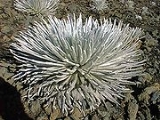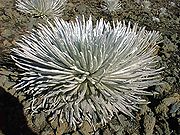
Deserts and xeric shrublands
Encyclopedia
Desert
s and xeric shrublands is a biome
characterized by, relating to, or requiring only a small amount of moisture.
or hyperarid climate, characterized by a strong moisture deficit, where annual potential loss of moisture from evapotranspiration
well exceeds the moisture received as rainfall. Deserts and xeric shrublands occur in tropical, subtropical, and temperate
climate regions.
Desert soil
s tend to be sandy or rocky, and low in organic materials. Saline
or alkaline soils are common.
Plant
s and animal
s in deserts and xeric shrublands are adapted to low moisture conditions. Hyperarid regions are mostly devoid of vegetation and animal life, and include rocky deserts and sand dunes. Vegetation in arid climate regions can include sparse grassland
s, shrubland
s, and woodland
s. Plants adapted to arid climates are called xerophyte
s, and include succulent plant
s, geophytes, sclerophyll
, and annual plant
s. Animals, including insect
s, reptile
s, arachnid
s, bird
s and mammal
s, are frequently nocturnal to avoid moisture loss.

to desert conditions is known as desertification
, and can occur from a variety of causes. One factor is human intervention in imposing intensive agricultural tillage or overgrazing in areas which cannot support such exploitation. Climatic shifts such as global warming
or the Milankovitch cycle (which drives glacials and interglacials) also affect the pattern of deserts on Earth.
Desert
A desert is a landscape or region that receives an extremely low amount of precipitation, less than enough to support growth of most plants. Most deserts have an average annual precipitation of less than...
s and xeric shrublands is a biome
Biome
Biomes are climatically and geographically defined as similar climatic conditions on the Earth, such as communities of plants, animals, and soil organisms, and are often referred to as ecosystems. Some parts of the earth have more or less the same kind of abiotic and biotic factors spread over a...
characterized by, relating to, or requiring only a small amount of moisture.
Definition and occurrence
Deserts and xeric shrublands receive an annual average rainfall of ten inches or less, and have an aridArid
A region is said to be arid when it is characterized by a severe lack of available water, to the extent of hindering or even preventing the growth and development of plant and animal life...
or hyperarid climate, characterized by a strong moisture deficit, where annual potential loss of moisture from evapotranspiration
Evapotranspiration
Evapotranspiration is a term used to describe the sum of evaporation and plant transpiration from the Earth's land surface to atmosphere. Evaporation accounts for the movement of water to the air from sources such as the soil, canopy interception, and waterbodies...
well exceeds the moisture received as rainfall. Deserts and xeric shrublands occur in tropical, subtropical, and temperate
Temperate
In geography, temperate or tepid latitudes of the globe lie between the tropics and the polar circles. The changes in these regions between summer and winter are generally relatively moderate, rather than extreme hot or cold...
climate regions.
Desert soil
Soil
Soil is a natural body consisting of layers of mineral constituents of variable thicknesses, which differ from the parent materials in their morphological, physical, chemical, and mineralogical characteristics...
s tend to be sandy or rocky, and low in organic materials. Saline
Soil salination
Soil salinity is the salt content in the soil.- Causes of soil salinity :Salt-affected soils are caused by excess accumulation of salts, typically most pronounced at the soil surface. Salts can be transported to the soil surface by capillary transport from a salt laden water table and then...
or alkaline soils are common.
Plant
Plant
Plants are living organisms belonging to the kingdom Plantae. Precise definitions of the kingdom vary, but as the term is used here, plants include familiar organisms such as trees, flowers, herbs, bushes, grasses, vines, ferns, mosses, and green algae. The group is also called green plants or...
s and animal
Animal
Animals are a major group of multicellular, eukaryotic organisms of the kingdom Animalia or Metazoa. Their body plan eventually becomes fixed as they develop, although some undergo a process of metamorphosis later on in their life. Most animals are motile, meaning they can move spontaneously and...
s in deserts and xeric shrublands are adapted to low moisture conditions. Hyperarid regions are mostly devoid of vegetation and animal life, and include rocky deserts and sand dunes. Vegetation in arid climate regions can include sparse grassland
Grassland
Grasslands are areas where the vegetation is dominated by grasses and other herbaceous plants . However, sedge and rush families can also be found. Grasslands occur naturally on all continents except Antarctica...
s, shrubland
Shrubland
Shrubland, scrubland, scrub or brush is a plant community characterized by vegetation dominated by shrubs, often also including grasses, herbs, and geophytes. Shrubland may either occur naturally or be the result of human activity...
s, and woodland
Woodland
Ecologically, a woodland is a low-density forest forming open habitats with plenty of sunlight and limited shade. Woodlands may support an understory of shrubs and herbaceous plants including grasses. Woodland may form a transition to shrubland under drier conditions or during early stages of...
s. Plants adapted to arid climates are called xerophyte
Xerophyte
A xerophyte or xerophytic organism is a plant which has adapted to survive in an environment that lacks water, such as a desert. Xerophytic plants may have adapted shapes and forms or internal functions that reduce their water loss or store water during long periods of dryness...
s, and include succulent plant
Succulent plant
Succulent plants, also known as succulents or fat plants, are water-retaining plants adapted to arid climates or soil conditions. Succulent plants store water in their leaves, stems, and also in roots...
s, geophytes, sclerophyll
Sclerophyll
Sclerophyll is the term for a type of vegetation that has hard leaves and short internodes . The word comes from the Greek sclero and phyllon ....
, and annual plant
Annual plant
An annual plant is a plant that usually germinates, flowers, and dies in a year or season. True annuals will only live longer than a year if they are prevented from setting seed...
s. Animals, including insect
Insect
Insects are a class of living creatures within the arthropods that have a chitinous exoskeleton, a three-part body , three pairs of jointed legs, compound eyes, and two antennae...
s, reptile
Reptile
Reptiles are members of a class of air-breathing, ectothermic vertebrates which are characterized by laying shelled eggs , and having skin covered in scales and/or scutes. They are tetrapods, either having four limbs or being descended from four-limbed ancestors...
s, arachnid
Arachnid
Arachnids are a class of joint-legged invertebrate animals in the subphylum Chelicerata. All arachnids have eight legs, although in some species the front pair may convert to a sensory function. The term is derived from the Greek words , meaning "spider".Almost all extant arachnids are terrestrial...
s, bird
Bird
Birds are feathered, winged, bipedal, endothermic , egg-laying, vertebrate animals. Around 10,000 living species and 188 families makes them the most speciose class of tetrapod vertebrates. They inhabit ecosystems across the globe, from the Arctic to the Antarctic. Extant birds range in size from...
s and mammal
Mammal
Mammals are members of a class of air-breathing vertebrate animals characterised by the possession of endothermy, hair, three middle ear bones, and mammary glands functional in mothers with young...
s, are frequently nocturnal to avoid moisture loss.

Desertification
The conversion of productive drylandsDrylands
Drylands is a Miles Franklin Award winning novel by Australian author Thea Astley. This novel shared the award with Benang by Kim Scott.-Awards:...
to desert conditions is known as desertification
Desertification
Desertification is the degradation of land in drylands. Caused by a variety of factors, such as climate change and human activities, desertification is one of the most significant global environmental problems.-Definitions:...
, and can occur from a variety of causes. One factor is human intervention in imposing intensive agricultural tillage or overgrazing in areas which cannot support such exploitation. Climatic shifts such as global warming
Global warming
Global warming refers to the rising average temperature of Earth's atmosphere and oceans and its projected continuation. In the last 100 years, Earth's average surface temperature increased by about with about two thirds of the increase occurring over just the last three decades...
or the Milankovitch cycle (which drives glacials and interglacials) also affect the pattern of deserts on Earth.
See also
- DesertDesertA desert is a landscape or region that receives an extremely low amount of precipitation, less than enough to support growth of most plants. Most deserts have an average annual precipitation of less than...
- Shrub-steppeShrub-steppeShrub-steppe is a type of low rainfall natural grassland. Shrub-steppes are distinguishable from deserts, which are too dry to support a noticeable cover of perennial grasses or other shrubs, while the shrub-steppe has sufficient moisture levels to support a cover of perennial grasses and/or...
- Temperate grasslands, savannas, and shrublandsTemperate grasslands, savannas, and shrublandsTemperate grasslands, savannas, and shrublands is a terrestrial biome whose predominant vegetation consists of grasses and/or shrubs. The climate is temperate and semi-arid to semi-humid....
- Sagebrush steppeSagebrush steppeThe sagebrush steppe is a type of shrub-steppe, which is a dry-xeric environment and plant community found in the Western United States and western Canada...
- MesicMesic habitatIn ecology, a mesic habitat is a type of habitat with a moderate or well-balanced supply of moisture, e.g., a mesic forest, a temperate hardwood forest, or dry-mesic prairie. Compared to a dry habitat, a mesic habitat is moister....
- Hydric
Desert and xeric shrublands ecoregions
External links
- Deserts and xeric shrublands (World Wildlife Fund)
- Map of the ecozones
- Index to Deserts & Xeric Shrublands at bioimages.vanderbilt.edu
- Xeric World Online Community focused on the study of Xeric Plant Species.

